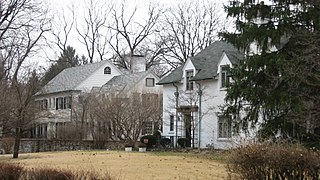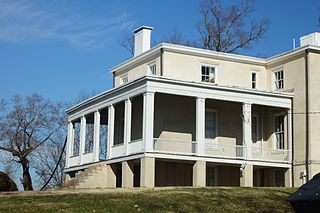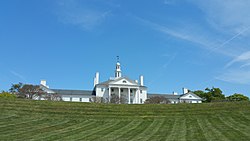
Hollywood Cemetery is a historic rural cemetery located at 412 South Cherry Street in the Oregon Hill neighborhood of Richmond, Virginia. It was established in 1847 and designed by the landscape architect John Notman. It is 135-acres in size and overlooks the James River. It is the only cemetery other than Arlington National Cemetery that contains the burials of two United States Presidents, James Monroe and John Tyler.

Oregon Hill is a historic working-class neighborhood in Richmond, Virginia. Oregon Hill overlooks the James River and Belle Isle, and provides access to Hollywood Cemetery. Due to the neighborhood's proximity to the Monroe Park Campus of Virginia Commonwealth University, the neighborhood is sometimes referred to as a student quarter because of its high college student population.

John Harvie was an American Founding Father, lawyer and builder from Virginia. He was a delegate to the Second Continental Congress, where he signed the Articles of Confederation, in 1777 and 1778. He was a successful lawyer and landowner, as well as the fourth mayor of Richmond, Virginia. Thomas Jefferson was a friend since his childhood; his father was Jefferson's guardian. He negotiated a peace treaty in 1774 after the Battle of Point Pleasant. During the American Revolutionary War, he was on the Board of War and operated a prison of war camp on his property, The Barracks.

Saint Anne's Park is a 240-acre (97 ha) public park situated between Raheny and Clontarf, suburbs on the northside of Dublin, Ireland. It is owned and managed by Dublin City Council.

Hollin Hills is a historic district and neighborhood in southeast Fairfax County, Virginia. It is located primarily in the Fort Hunt area of the county with some portions remaining in the Hybla Valley and Groveton areas since a shift for census purposes prior to 2010. The community contains more than 30 acres (12 ha) of parkland across seven distinct parks, a pool and swim club, a bocce court, and a pickleball and tennis club, operated and maintained by the Civic Association of Hollin Hills (CAHH).

Warren Henry Manning was an American landscape designer and promoter of the informal and naturalistic "wild garden" approach to garden design. In his designs, Manning emphasized pre-existing flora through a process of selective pruning to create a "spatial structure and character." An advocate for the conservation of the American landscape, Manning was a key figure in the formation of the American Society of Landscape Architects and a proponent of the National Park System.

Castle Hill is a 56,881 sq ft (5,284.4 m2) mansion in Ipswich, Massachusetts, which was completed in 1928 as a summer home for Mr. and Mrs. Richard Teller Crane, Jr. It is also the name of the 165-acre (67 ha) drumlin surrounded by sea and salt marsh that the home was built atop. Both are part of the 2,100-acre (850 ha) Crane Estate, located on Argilla Road. The estate includes the historic mansion, 21 outbuildings, and landscapes overlooking Ipswich Bay on the seacoast off Route 1, north of Boston. Its name derives from a promontory in Ipswich, Suffolk, England, from which many early Massachusetts Bay Colony settlers immigrated.

Golden Hill is an affluent and historic neighborhood overlooking the White River on the west side of Indianapolis's Center Township, in Marion County, Indiana. The district is bounded on the east by Clifton Street, which is west of Martin Luther King Jr. Boulevard ; on the west by the White River and the Central Canal; on the south by Thirty-sixth Street; and on the north by Woodstock Country Club, immediately south of Thirty-eighth Street. Golden Hill is noted for its collection of homes designed by several of the city's prominent architects. The estate homes reflect several styles of period revival architecture. The district is known as for its community planning and remains an exclusive enclave for the city's prominent families. Golden Hill was added to the National Register of Historic Places in 1991.

Forest Hill Park, known for its "Stone house" called Boscobel, is a historic 105-acre (0.4 km2) urban park in Richmond, Virginia. Starting as a private property, the park has had several owners and uses before its present one, the City of Richmond.

Oldfields, also known as Lilly House and Gardens, is a 26-acre (11 ha) historic estate and house museum at Newfields in Indianapolis, Indiana, United States. The estate, an example of the American country house movement of the late nineteenth and early twentieth centuries, was designated a U.S. National Historic Landmark in 2003.
Charles Freeman Gillette (1886–1969) was a prominent landscape architect in the upper South who specialized in the creation of grounds supporting Colonial Revival architecture, particularly in Richmond, Virginia. He is associated with the restoration and re-creation of historic gardens in the upper South and especially Virginia. He is known for having established a regional style—known as the "Virginia Garden."

Lemon Hill is a Federal-style mansion in Fairmount Park, Philadelphia, built from 1799 to 1800 by Philadelphia merchant Henry Pratt. The house is named after the citrus fruits that Pratt cultivated on the property in the early 19th century.

Virginia House is a manor house on a hillside overlooking the James River in the Windsor Farms neighborhood of Richmond, Virginia, United States.

Elk Hill, also known as Harrison's Elk Hill, is a historic plantation home located near Goochland, Goochland County, Virginia. It was built between 1835 and 1839, and is a 2+1⁄2-story, three-bay, stuccoed brick central-hall-plan house in the Greek Revival style. It has a two-story rear ell. The front facade features a one-story Tuscan order portico consisting of paired rectangular wooden pillars supporting a full entablature. Also on the property are the contributing servants' quarters, tack house, and spring house. It was listed on the National Register of Historic Places in 1979.

E. Hervey Evans House is a historic home located at Laurinburg, Scotland County, North Carolina. It was designed by architect John A. Weaver with initial plans presented to his clients on June 2, 1939. Weaver was employed in the Architectural Department of Macy's Department Store and listed his office as 1328 Broadway, NYC. Hervey Evans was an executive of various enterprises owned by his grandfather, John F. McNair. Evans was instrumental in selecting Weaver to design the Arts and Crafts style McNair's Department Store in 1938.

Belmont Plantation, also known as Belmont Estate and Belmont, is a locale in Albemarle County, Virginia, and the site of a 19th-century plantation. It was among the first patents in Albemarle County, patented in the 1730s. Matthew Graves sold a 2,500-acre-tract to John Harvie Sr., a friend of Peter Jefferson and a guardian of Thomas Jefferson. After his death in 1767, the property was inherited by his son John Harvie, Jr. Harvie lived at Belmont for several years, but after he was appointed the Registrar of Land Grants, he moved to Richmond, Virginia and John Rogers oversaw the plantation. Rogers was known for his progressive approaches to agriculture, including methods for improving the quality of the soil after years of tobacco crops.

Bellamont House is a Georgian Palladian-style house set amongst 1,000 acres of grounds in Cootehill, County Cavan, Ireland. The house was completed in 1730 for Judge Thomas Coote and likely designed by his nephew, the architect Edward Lovett Pearce.

Pratt's Castle was a home located in the historic Gambles Hill neighborhood of Richmond, Virginia. Built in 1854, the structure was a rare Virginia example of Gothic Revival architecture.


















